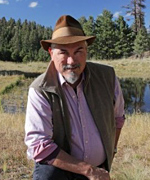 —Alan Dulaney
—Alan Dulaney
Arizonans outside the Active Management Areas are always suspicious of moves to regulate what they consider to be theirs, like groundwater. They opted out of regulation under the 1980 Groundwater Management Act, under the premise that groundwater mining was not an issue outside Maricopa, Pinal, and Pima Counties. That thinking was on display in late July at the kickoff meeting of the Non-AMA Groundwater Committee, a subset of the Governor’s Water Augmentation Innovation and Conservation Council.
The agenda was carefully constructed to be relatively neutral, acknowledging the concerns of both those in favor of more regulation in the face of dwindling groundwater supplies and those what want to avoid any new regulation. Yet it was red meat thrown to the lions, and elicited strong opinions and many pet themes.
Many of the participants were familiar faces from the Drought Contingency Plan discussions, minus most players from the AMAs or tribes. Distinct views concerning groundwater were often in total opposition. Many noted the need for water level measurements and more data, which raised the ire of some that said ADWR already has sufficient data and intrusions into private lands were not wanted. This rural animosity towards regulation presents a formidable barrier to dealing with concerns seen by some, but by no means all, interests. Several noted said that no crisis existed across most of the state, and that private property rights had to be respected. Many rural areas have no alternative supplies, and cannot allow any interference in the existing uses of groundwater.
However, representatives of La Paz, Mohave and Cochise Counties sounded a different note. Within the last few years, large farming operations owned out of state have constructed irrigation wells that are overpumping specific basins (some of which were meant to be huge master-planned communities 15 years ago). Kingman can foresee impacts to municipal groundwater supplies in as little as 7 years due to overpumping. Existing farms and communities in multiple basins now feel threatened. Long-term residents and their businesses could be damaged. They worry that voluntary controls will not be enough to allow everyone to coexist on the same supply of groundwater.
Key concepts under discussion included “private property rights” and “voluntary alternatives.” All seemed to agree that the best approach lies in the planning areas defined by ADWR. No one seemed uncomfortable with the suggestion that ADWR present more information, possibly modeling results, for various planning area, especially those facing serious challenges. The talk about private property rights almost sounded like some still regarded groundwater as a private property right, even though it was pointed out multiple times that the Arizona Supreme Court had ruled long ago that groundwater was for the public, and not a private property right. Several participants noted that each planning area would be different, and the same approach to controls on withdrawals (voluntary or regulatory) would not work across all areas. The resistance to installing flow meters and reporting pumpage is real and may drive thinking in the absence of any outside pressure or perceived crisis.
The original Groundwater Management Act was passed to enable construction of the CAP canal and the delivery of replenishable supplies to the three-county service area. However, for other counties no promise of alternative replenishable supplies can be made, nor will outside pressure move the ideological needle. These discussions are needed, but it is not yet clear if they will provide any meaningful result. Meanwhile the pumping continues.